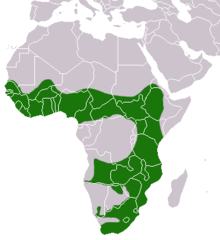African clawless otter
| African clawless otter | |
|---|---|
 |
|
| Scientific classification | |
| Kingdom: | Animalia |
| Phylum: | Chordata |
| Class: | Mammalia |
| Order: | Carnivora |
| Family: | Mustelidae |
| Subfamily: | Lutrinae |
| Genus: | Aonyx |
| Species: | A. capensis |
| Binomial name | |
|
Aonyx capensis (Schinz, 1821) |
|
 |
|
| African clawless otter range | |
The African clawless otter (Aonyx capensis), also known as the Cape clawless otter or groot otter, is the second-largest freshwater species of otter. African clawless otters are found near permanent bodies of water in savannah and lowland forest areas. They range through most of sub-Saharan Africa, except for the Congo River basin and arid areas. They are characterized by partly webbed and clawless feet, from which their name is derived.
Aonyx capensis is a member of the weasel family (Mustelidae) and of the order Carnivora. The earliest known species of otter, Potamotherium valetoni, occurred in the upper Oligocene of Europe: A. capensis first appears in the fossil record during the .Aonyx is closely related to the extinct giant Sardinian otter, Megalenhydris.
Mammal Species of the World lists six subspecies of Aonyx capensis:
However, some authorities consider the Congo/Cameroon clawless otter to be a separate species (A. congicus). Under this view, only the first three of the above list would be subspecies of A. capensis.
African clawless otters have thick, smooth fur with almost silky underbellies. Chestnut in color, they are characterized by white facial markings that extend downward towards their throat and chest areas. Paws are partially webbed with five fingers, and no opposable thumbs. All lack claws except for digits 2, 3, and 4 of the hind feet. Their large skulls are broad and flat, with relatively small orbits and short rostra. Molars are large and flat, used for crushing of prey. Male otters are slightly larger than females on average. Adults are 113–163 cm (45–64 in) in length, including their tails that comprised about a third of their length. Weights can range from 10–36 kg (22-80 lbs), with most otters averaging between 12 and 21 kg (26-46 lbs). Despite being closely related to the oriental small-clawed otter, the African clawless otter is often twice as massive as that relatively diminutive mustelid.
...
Wikipedia

